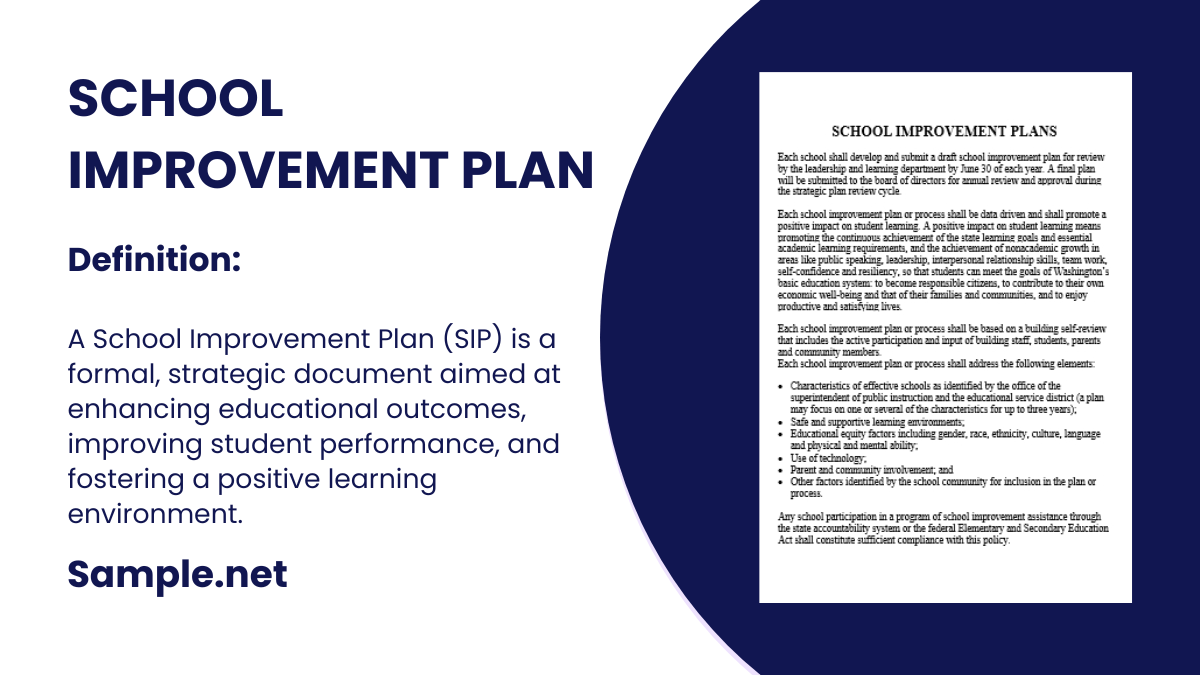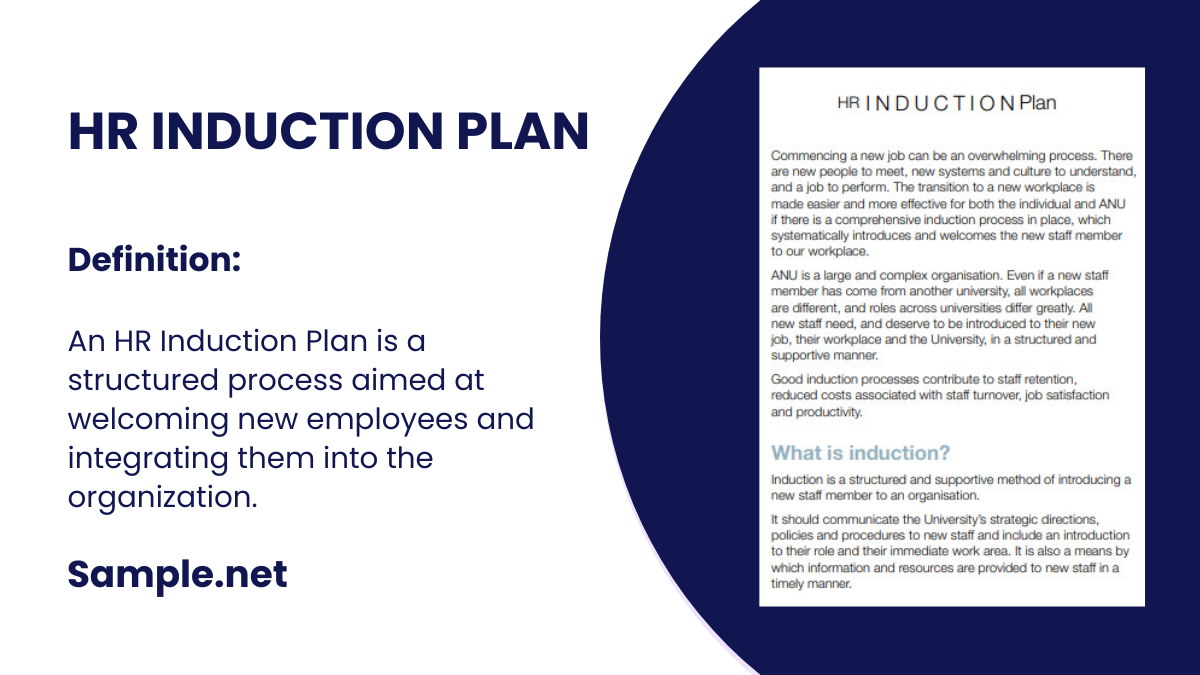A School Improvement Plan is a strategic blueprint aimed at enhancing educational outcomes for students. It outlines clear goals, targeted actions, and measurable benchmarks to ensure continuous development in…
continue reading
8+ Sample HR Department Plan
-
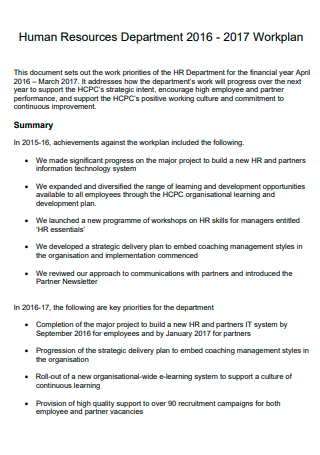
Human Resources Department Work Plan
download now -
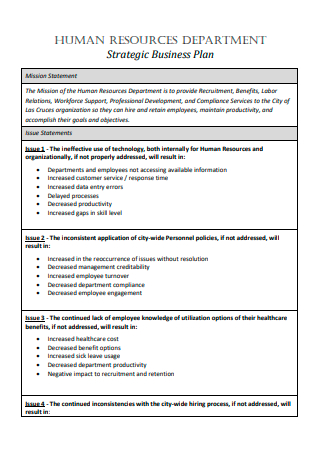
Human Resources Department Strategic Business Plan
download now -
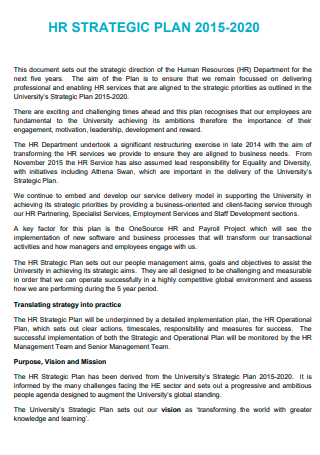
HR Strategic Department Plan
download now -

Human Resources Department Planning Matrix
download now -
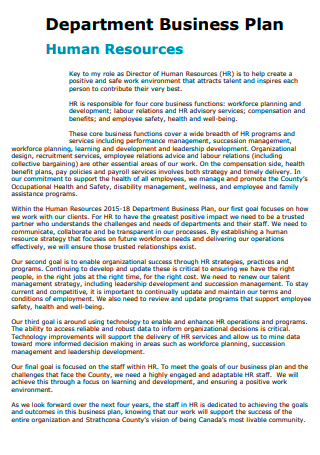
Human Resources Department Business Plan
download now -
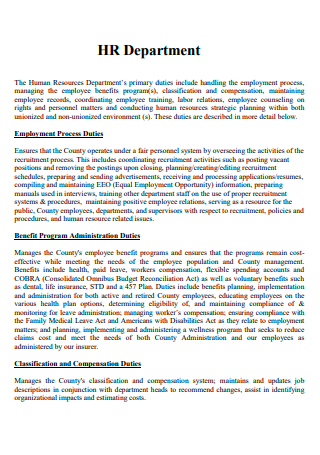
HR Department Plan Example
download now -
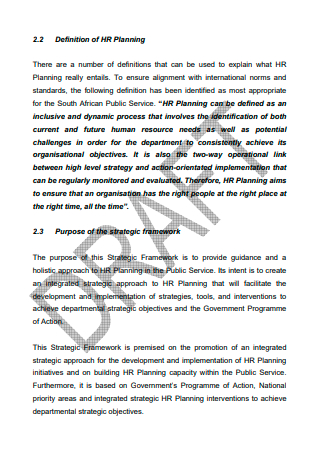
Draft HR Department Planning
download now -
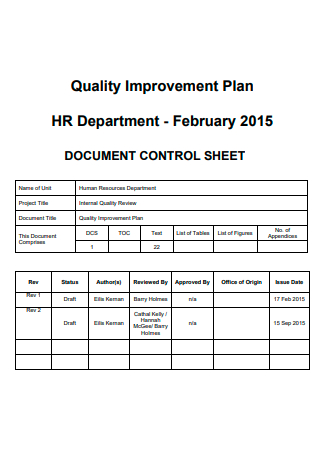
HR Department Quality Improvement Plan
download now -

HR Department Racial Equity Action Plan
download now
What Is an HR Department Plan?
An HR department plan is a systematic process by which an organization determines how to implement staffing to meet business and customer demands. It ensures that the company has the appropriate personnel for the job while avoiding any workforce shortages or surpluses. Planning for the human resources department encompasses all facets of employee management, from hiring to training and everything in between. More importantly, it enables a business to address its employees’ concerns and improve job evaluation adequately. According to studies, roughly 85% of employed Americans leave their present job for better benefits and a more flexible work environment, among other reasons. For most organizations, acquiring and maintaining the appropriate personnel is not easy. This is why human resources are critical to the success of every organization, large or small.
Benefits of HR Department Planning
Planning for an HR department can be a lengthy and tedious process. It requires considerable effort – brainstorming, debate, decision-making, and analysis, among other things – but it is one of the riskiest tasks that should assist the HR team in accomplishing their objectives. The following are the primary advantages of human resource department planning:
Tips for HR Planning
Human resources are a company organization’s most valuable asset. A business must have a method for human resource planning (HRP). Human resource planning is a continuous activity that an organization’s human resources department should carry out to ensure methodical planning to maximize the benefits of available human resources. Human resource planning ensures that personnel is a good fit for their job functions and the business culture. This enables the organization to run without experiencing workforce surpluses or shortages.
1. Analyze Goals
The human resource planning method begins with identifying the objectives of the organization’s various departments. For example, each department, such as management, marketing, production, finance, and sales, may have distinct goals and expectations for human resources. The objectives may include:
- Hiring new personnel for the process.
- Automating operations to reduce employee count.
- Enhancing the knowledge and skill levels of existing employees.
The human resources planning team can identify essential adjustments for the organization’s future by assessing the objectives of each department. Research shows that project managers and process improvement teams frequently use gap analysis reports in information technology. Small businesses, in particular, might benefit from gap studies when determining how to allocate resources.
2. Conduct an inventory of present human resources.
Once the essential modifications have been identified, the human resources planning team should inventory the organization’s current human resources. This should cover the organization’s existing staff count and their capacities, talents, and performance abilities. This enables the human resources staff to determine the best strategies for filling impending employment requirements and budget for essential internal and external recruitment.
3. Calculate Gaps
Comparing the demand and supply of employee availability enables the human resources team to anticipate potential gaps soon. The gaps might manifest themselves as both employment shortfalls and surpluses. Employment deficits show the number of vacant positions that must be filled, while employment surpluses reflect job terminations or transfers across departments. Apart from that, the gaps might be used to determine the employees’ training and development needs.
4. Create and execute a plan.
After estimating employment gaps, the human resources planning team should establish a strategy for recruiting, training, development, termination, interdepartmental transfers, promotion, or early retirement of employees according to the organization’s requirements. The employment strategy may vary according to the deficit or excess projected during the demand and supply stage forecasting. After developing a human resources strategy, the human resources department should implement the process throughout the organization. This should be consistent with the organization’s goals and objectives and with each department within the business.
5. Be in control and give feedback.
Once the human resources plan is implemented, it should be assessed continuously to ensure that it remains aligned with the departments’ objectives. Controls should be implemented and feedback acquired at each level to determine any deficiencies in the executed human resource plan. Require changes should be adopted in response to input gathered during the ongoing process to ensure the effectiveness of the human resources plan.
How To Conduct an HR Department Plan
How are human resource department plans implemented? Because human resource management encompasses a wide range of activities, from recruitment to hiring, training, and development, and dealing with change, there are several necessary procedures to ensure that everything is handled efficiently.
Step 1: Capacity assessment of human resources.
One of the first phases in human resource department planning is determining an organization’s current workforce requirements. It is a critical stage in the management of human resources. Before hiring new personnel or creating a completely new position or role, an organization must appraise the talent presently on hand. Human resource departments should assess workforce capacity in various ways, including reviewing prior performance reports and soliciting employee comments.
Step 2: Determining HR requirements.
The HR department’s purpose is to ensure that the organization’s personnel demands are met. All job openings are filled, new jobs are established when organizational needs dictate, and present employment levels are sufficient to satisfy day-to-day output. Additionally, the human resources department must predict workforce requirements for the next few months or years. They must determine whether to acquire additional staff or retain existing staff while improving their skills and productivity through training and development. There should be a greater emphasis on controlling the organization’s workforce supply and demand. Two tasks must be completed during the planning phase: supply forecasting and demand forecasting. Forecasting the collection of human resources entails determining the resources available to meet the organization’s workforce requirements. Demand forecasting is the method of evaluating future human resource requirements. Two things must be resolved throughout this process: the number of people to be employed and the type of talent required to fill the roles.
Step 3: Integrating human resource strategies into the entire corporate process.
After reviewing present human resource capacity, it’s time to align the plan with the organization’s overarching strategy to garner buy-in from leaders and stakeholders. Strategic planning is used to determine why a firm exists and what its long-term goals are. Because human resources are involved in every aspect of a business – from product development to production, marketing, and so on – they are regarded as the organization’s most valuable asset. If the company does not hire the right people to accomplish its objectives, the strategic strategy will fail.
Step 4: Developing a strategy to satisfy forecasted supply and demand.
After assessing the organization’s staffing requirements, the human resources team must establish a strategy for recruiting, retaining, and strengthening the workforce. Numerous details must be found, including the recruitment schedule, how it should be conducted.
Step 5: Developing recruitment and selection guidelines.
Recruitment is the first step in talent development. This entails posting a job on various channels, including the company’s website, a talent or networking website, and so forth. The selection procedure begins with the pooling of qualified applications.
FAQs
Why are human resources so critical?
Human resources are critical in building, strengthening, and changing an organization’s culture. Pay, performance management, training and development, recruitment and onboarding, and reiterating the organization’s values are all critical components of the business culture that HR oversees.
What is human resource strategy?
A human resource strategy is an organization’s overarching plan for managing its human resources by its business objectives. The human resource strategy establishes the direction for all critical aspects of human resource management, including recruitment, appraisal evaluation, development, and remuneration. According to research, human resource executives identified this as the most critical strategic activity they could undertake; non-human resource leaders ranked it fourth. Evaluating strategic business alternatives, including their associated costs and advantages. Human resource executives tagged this as the second most strategic action they could take.
What is referred to as staffing?
Staffing is the process of identifying the best candidate with the necessary skills and experience and hiring them to fill a job post or function. In management, staffing recruits people by evaluating their abilities and expertise and assigning them specific job responsibilities based on their qualifications. Staffing companies often charge between 25% and 100% of the earnings of the hired person. Thus, if you and the employment agency agree on a 50% markup and the new employee makes $10 per hour, you will pay the agency $15 per hour for their labor.
Is human resources responsible for payroll?
In most firms, payroll functions are handled by either the finance or human resources departments. Payroll is also considered a function of human resources because it pays and deals with individuals.
Human resource planning is critical for any business. It assists firms in addressing employee shortages or hurdles before such issues arise. Although creating an HR department can be a complex, time-consuming process that involves making critical decisions. Human resource departments can encourage efficient planning by utilizing a range of tools and methodologies. These include human resource data analytics, personnel databases, detailed organizational charts, and random access memory. With a firm’s understanding of the process, it is possible to adopt the optimal plan for assembling the best staff.
